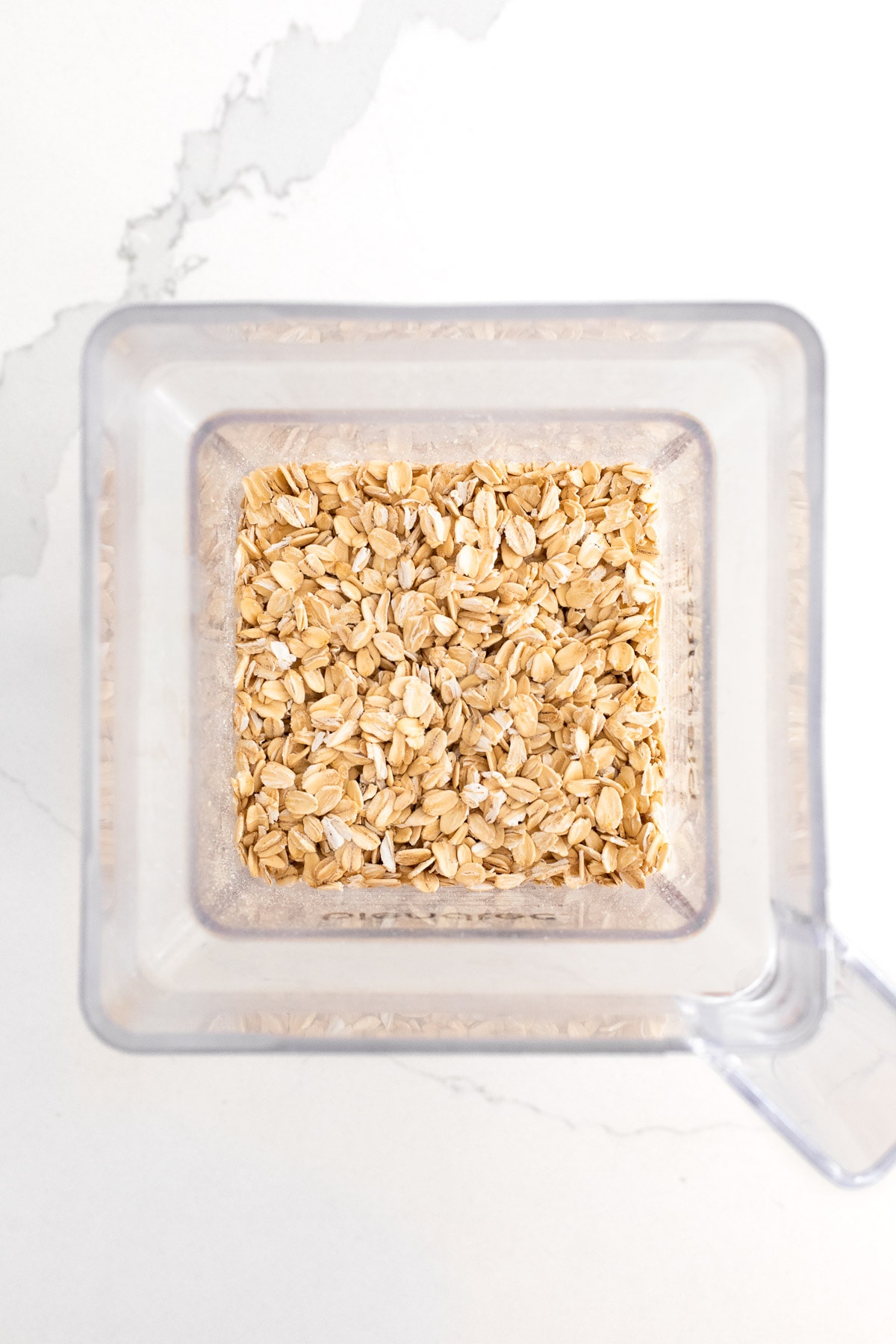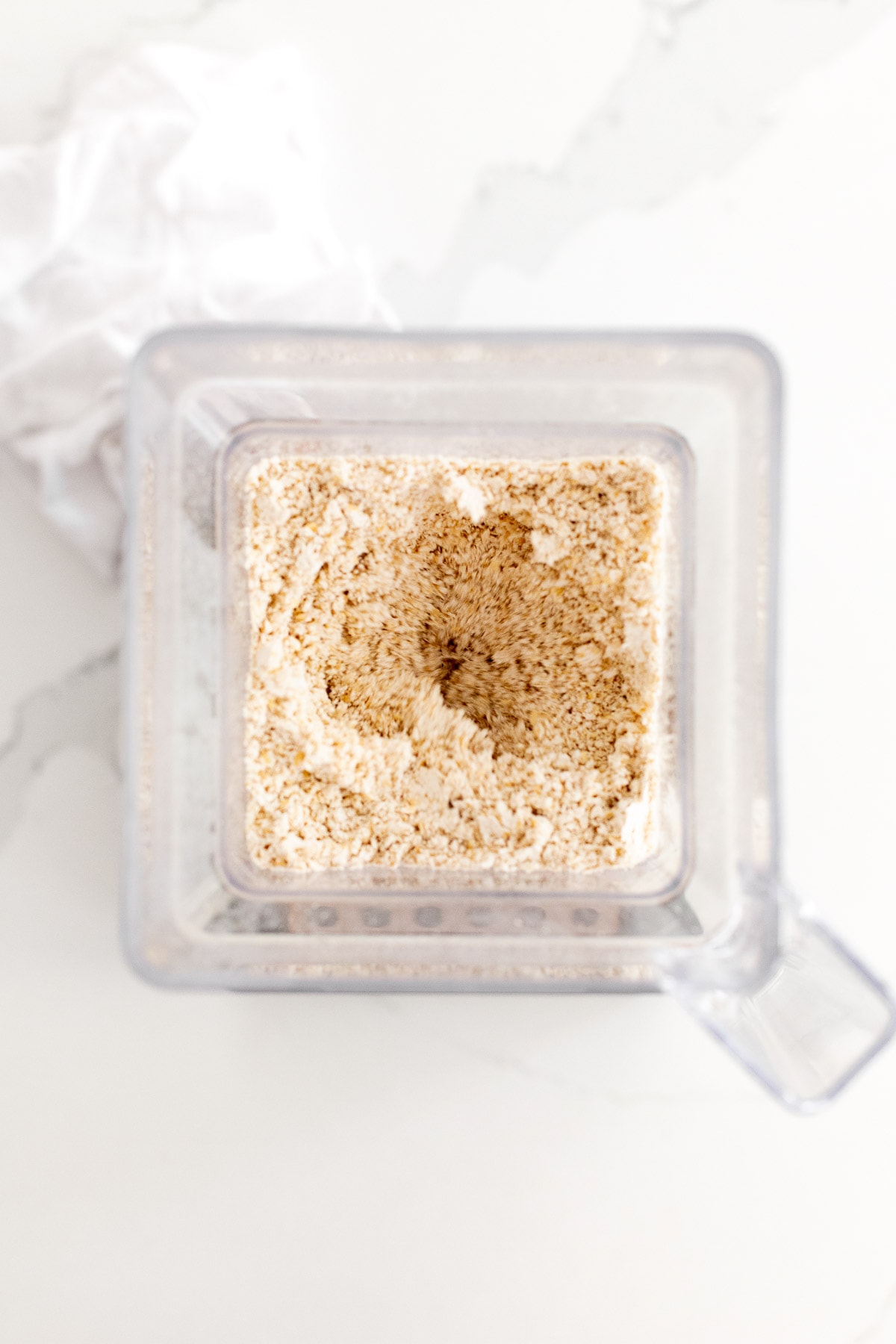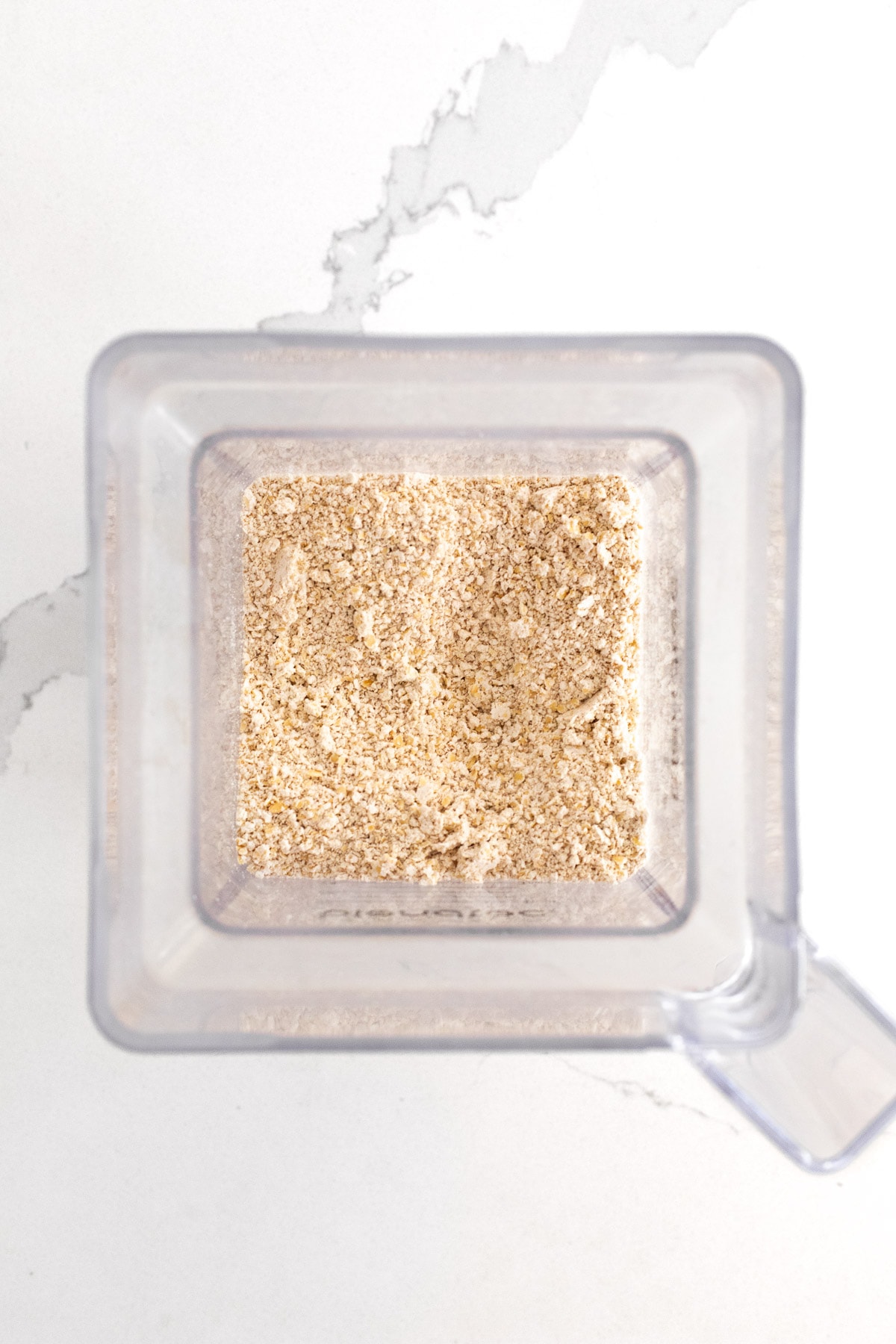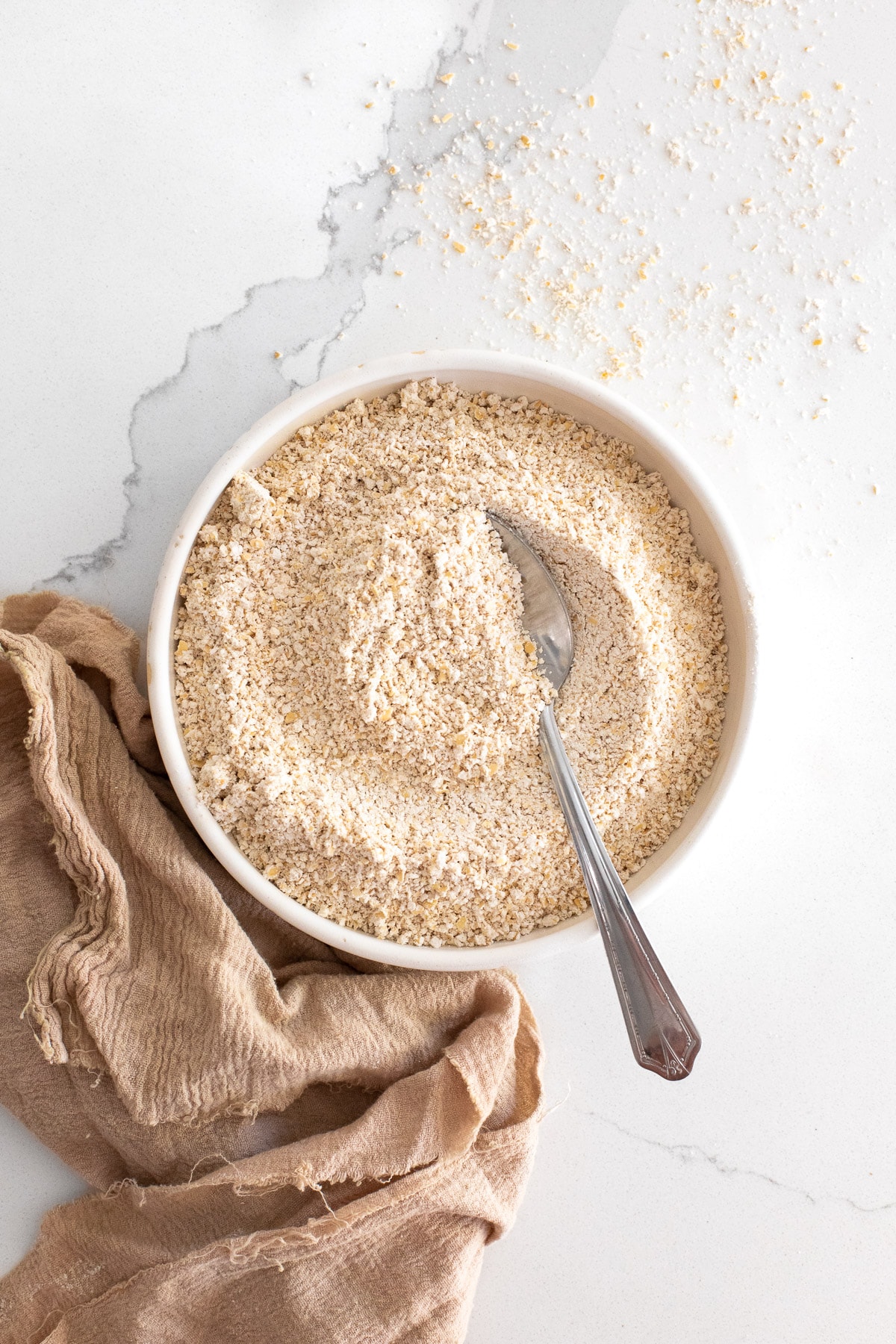Learn how to make oat flour at home using one simple ingredient - oats! It takes less than 5 minutes and works wonderfully in a variety of recipes to boost nutrition and flavor. It’s a great gluten-free flour option, but can also be used to add a delicate, tender texture to any type of baked good!
Although often overlooked, oat flour is such a great ingredient for adding a healthier twist to a sweet treat. With its high fiber content and array of vitamins and minerals, it contributes more nutritional value to a recipe than traditional all-purpose flour could ever hope to do. And despite that, it won’t take away from the flavor of your favorite recipes - a true win-win!
You can buy oat flour in most stores, but I’d be willing to wager that you already have oats at home. So save yourself a trip, and let me show you how easy it is to make at home!
Jump to:
What is Oat Flour
Put simply, it's nothing more than finely ground oats! The process of grinding whole oats turns them into a powdery substance with a texture that not only resembles wheat flour but also functions in much the same way in a variety of recipes.
It’s most commonly made with old fashioned (rolled) oats, but steel cut or quick-cooking oats can be used as well. And while it isn’t 100% interchangeable with all-purpose flour in every recipe, it can be used in conjunction with other flours to boost a recipe’s nutritional content, and can also be used solo in certain recipes. More on that later!
Benefits of Oat Flour
There are a whole host of reasons I love using oat flour in a recipe! Here are a few of its benefits:
- Nutrition: Pre the USDA, 30 grams of oat flour contains roughly 4 grams of fiber, compared to less than 1 gram in an equivalent amount of all-purpose flour. Oats are also a good source of phosphorous, magnesium, zinc, manganese, and vitamin B (thiamin and biotin), among other vitamins and minerals.
- Accessibility: While oat flour may not be available in every grocery store, oats nearly always are. It's just a matter of taking a few minutes to grind oats that are probably already sitting in your pantry - easy!
- Gluten-free friendly: Oats are naturally gluten-free, and so is oat flour. It’s a great ingredient to have on hand for gluten-free baking and healthy recipes.
- Texture: Oat flour gives baked goods a soft, tender crumb and slightly dense texture, making it a great addition to muffins, quick breads, and similar recipes.
- Flavor: The slightly sweet, nutty flavor of oat flour can also add more dimension to recipes - especially ones that feature particularly warm and rich flavors. This pear crumble is one of my favorite examples!
- Cost: Depending on where you buy your groceries, it tends to be at least slightly less expensive to make your own oat flour versus buying it. For example, my local grocery store sells oat flour for $.45/oz, and rolled oats for $0.30/oz. At roughly 3.32 ounces (94 grams) per cup of flour, that’s a difference of $0.50/cup.
What You’ll Need
You can DIY oat flour as long as you have two things: oats and a way to grind them - typically a blender or a food processor.
Oat Varieties
Old fashioned rolled oats: These are the standard oats you’ll find in most grocery stores, and what I recommend using for this oat flour recipe.

Quick cooking oats: Oats that have been steamed for a longer period than old-fashioned oats and cut into smaller pieces are referred to as quick oats. They can also be used here. Don't confuse them with instant oats, which have an even finer texture and are often sold with added flavors and sweeteners.
Steel-cut oats: Whole oat groats that have been sliced into small pieces - but not flattened like quick-cooking or old fashioned oats - are known as steel cut oats. They have a much harder texture than the other two varieties, and because of that, they’ll take much more force to grind down. If you have a high-powered blender, you can attempt to use steel cut oats, but my recommendation is to stick with one of the other two varieties.
Equipment
I prefer making oat flour with my blender. A high-quality brand such as Blendtec or Vitamix will make quick work of it, but even a more middle-of-the-road option like a Ninja or NutriBullet should do the trick.
A food processor fitted with the steel blade attachment can also be used. It works best with a larger quantity of oats (3+ cups), but I find that the flour does tend to require sifting afterward.
In a pinch, you can even use a coffee grinder! This method is best for small quantities of oats - if you use too much, they won’t grind evenly.
How to Make Oat Flour
Once you have your oats and kitchen appliance of choice, there’s only one simple step to complete!
Add the oats to the blender (or other appliance) and blend/process until they’ve reached a flour-like consistency. This can take anywhere from 30 seconds to a few minutes depending on the tool you’re using and the speed/power. I tend use a medium-high speed (6-7) with my Blendtec, which takes about 1 minute to turn the oats into oat flour.
Keep in mind that a slight bit of texture in the flour is okay for most baking purposes. If you want extra-fine flour, you can sift it before using.


If you find that the oats are spinning around rather than catching the blade of the appliance, add more. I recommend working with at least 3 cups of oats at a time unless you’re using a coffee grinder, in which case you should start with ½ cup.
One cup of oats will yield approximately one cup of oat flour.

Storing Oat Flour
Homemade oat flour should be stored in some type of airtight container, tightly-lidded jar, or sealed plastic bag, in your pantry or refrigerator. The natural oils found in oats limit the shelf life of this flour, but it should stay fresh for anywhere from 3-6 months.
You can also store oat flour in the freezer to extend its shelf life!
How to use oat flour
With its ever-so-slightly nutty flavor, this flour is particularly well-suited to sweet(er) baked goods like bread, muffins, cookies, and pancakes. While it’s not a 1:1 substitution for all-purpose flour, baking with oat flour only is possible with the right recipe. If this is your goal, I recommend finding a recipe that was designed with this in mind, like my banana oat muffins, oat flour pumpkin muffins, or oat flour banana bread.
Here are a few helpful tips to be aware of when using oat flour in baking:
- Flour made with oats tends to absorb more moisture than flour made with other whole grains (think of the way oats absorb water to turn into oatmeal).
- 1 cup of oat flour weighs about 94 grams, whereas one cup of all-purpose flour clocks in at about 120 grams. This is important to keep in mind if you plan on using this flour in a recipe that calls for regular flour, and it’s why I always recommend measuring your ingredients by weight.
- Baked goods made with oat flour tend to be a bit denser and chewier, which is why this is a great flour to use for heartier treats!
- Oat flour does not contain gluten, so it cannot be used exclusively in yeast bread and similar recipes that rely on gluten to rise and expand in the oven.

More frequently asked questions
To help recipes made with oat flour rise properly, you need to use some form of leavener - typically baking powder or baking soda. Using eggs will also help with both binding and leavening in the absence of gluten.
While it may be possible in small batches, it’s not the most efficient method! It will likely take significantly longer to achieve the desired consistency, and the final product may not be as smooth as it would be with a high-speed blender or other, more powerful machine.
Yes, oats by nature do not contain gluten and are safe for anyone on a gluten-free diet. That said, oats grown or processed in facilities that also process glutenous grains can be contaminated, so if you have celiac disease or a gluten sensitivity, it's important to buy certified gluten-free oats to make your homemade oat flour gluten free.
I’ve found gluten-free oats at Sprouts, Trader Joe’s, Costco, and Amazon.
No-oat flour is relatively high in carbohydrates and therefore typically not considered a keto-friendly flour. While it might be used in small amounts in some low-carb or keto recipes, it’s generally not a recommended ingredient for anyone following a strict keto diet. Try almond flour or coconut flour instead!
More recipes made with oats
Don't stop here! I've got plenty of delicious ways to use up those oats sitting in your pantry:
Have you made this recipe?
If so, I'd love to hear your feedback; you can leave a rating and review in the comments section below! It's also so helpful if you help spread the word by sharing this post on your favorite social media channel. If you happen to snap a photo of what you've baked, be sure to share it on Instagram and tag me (@brighteyedbaker) so I can give you a shoutout!
How to Make Oat Flour
No need to head to the grocery store - here's how to make your own oat flour at home! All you need is fresh oats, and in less than 5 minutes you'll have a versatile flour that adds both nutrition and flavor to a wide range of recipes. It also makes a great wheat flour alternative in gluten-free baking!
- Total Time: 5 minutes
- Yield: approx. 3 cups
- Category: ingredients
- Method: blender
- Diet: Gluten Free
Ingredients
- 3 cups old fashioned or quick-cooking oats
Instructions
- Add the oats to a blender or food processor and blend until they reach a fine, flour-like consistency. This can take anywhere from 30 seconds to a few minutes depending on the tool you're using and its speed/power.
- If desired, sift flour before using to remove any larger bits of oats remaining.
Notes
Ingredient notes:
- Steel cut oats can theoretically be used but will take much longer to grind into flour.
- For 100% gluten-free oat flour, use certified gluten-free oats.
Equipment notes:
- If you don't own a blender or food processor, you can use a coffee/spice grinder. Work with smaller quantities (about ½ cup) of oats at a time.
Storing:
- Store flour in an airtight container or sealed bag in the pantry or refrigerator. It should stay fresh for anywhere from 3-6 months, but can also be kept in the freezer to extend its shelf life.
Helpful Tips:
- If you find that the oats are spinning around rather than catching the blade of the appliance, try adding more to increase the traction.
- 1 cup of oats (92 grams) will yield approximately 1 cup of oat flour (94 grams).












Sandra says
Brilliant! I am never without Oats! I don't buy flour per se so I think this is a great way to bake something I might not have otherwise. Thank you!
Gloria Diaz says
Great post and listed tips are wonderfully described.
lisa Barbiero says
where can I purchase a grain grinder like the one shown in the picture! Have been looking for one!!
alexandra says
It's actually just a coffee bean grinder, although if you have a KitchenAid, they do make a grain grinder attachment. :)